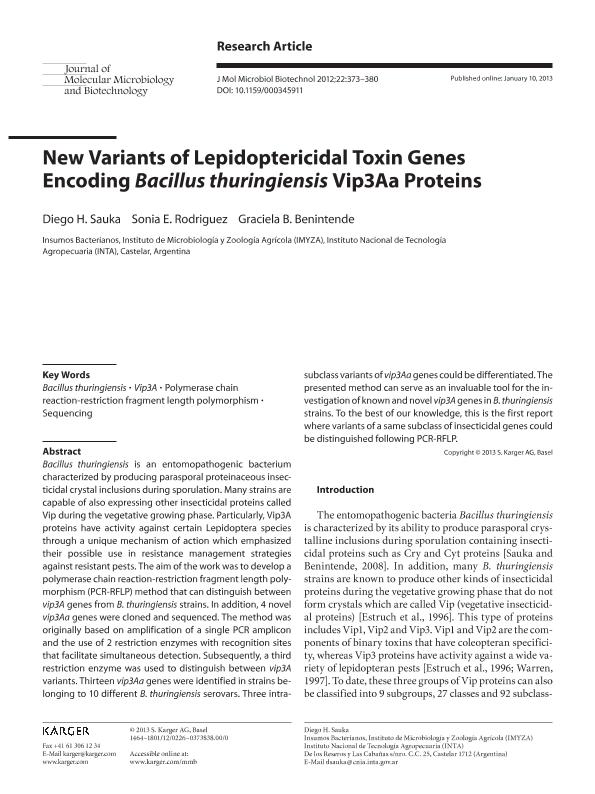Artículo
New variants of lepidoptericidal toxin genes encoding bacillus thuringiensis Vip3Aa proteins
Fecha de publicación:
03/2013
Editorial:
Karger
Revista:
Journal of Molecular Microbiology and Biotechnology
ISSN:
1464-1801
Idioma:
Inglés
Tipo de recurso:
Artículo publicado
Clasificación temática:
Resumen
Bacillus thuringiensis is an entomopathogenic bacterium characterized by producing parasporal proteinaceous insecticidal crystal inclusions during sporulation. Many strains are capable to also express other insecticidal proteins during the vegetative growing phase that are called Vip. Particularly, Vip3A proteins have activity against certain Lepidoptera species through a unique mechanism of action which emphasized their possible use in resistance management strategies against resistant pests. The aim of the work was to develop a PCR-RFLP method that can distinguish between vip3A genes from B. thuringiensis strains. In addition, four novel vip3Aa genes were cloned and sequenced. The method was originally based on amplification of a single PCR amplicon and the use of two restriction enzymes with recognition sites that facilitate simultaneous detection. Subsequently, a third restriction enzyme was use to distinguished between vip3A variants. Thirteen vip3Aa genes were identified in strains belonging to ten different B. thuringiensis serovars. Three intra-subclass variants of vip3Aa genes could be differentiated. The presented method can serve as an invaluable tool for the investigation of known and novel vip3A genes in B. thuringiensis strains. To the best of our knowledge, it is the first report where variants of a same subclass of insecticidal genes could be distinguished following PCR-RFLP.
Archivos asociados
Licencia
Identificadores
Colecciones
Articulos(SEDE CENTRAL)
Articulos de SEDE CENTRAL
Articulos de SEDE CENTRAL
Citación
Sauka, Diego Herman; Rodriguez, Sonia E.; Benintende, Graciela Beatriz; New variants of lepidoptericidal toxin genes encoding bacillus thuringiensis Vip3Aa proteins; Karger; Journal of Molecular Microbiology and Biotechnology; 22; 6; 3-2013; 373-380
Compartir
Altmétricas




